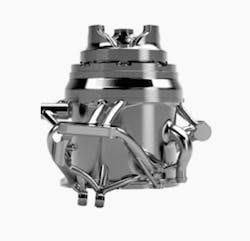Protolabs Expands 3D Printing Capacity and Capabilities
As use of 3D printing grows across industry due to the technology’s capability to produce assembly-ready parts, discrete manufacturers are realizing that 3D printing is an increasingly attractive option for parts production when costs per piece are high or when the part or product has special design requirements that make additive manufacturing/3D printing production more economical. According to Zach Gray of Siemens, the economics of 3D printing are particularly suitable for products manufactured in individualized mass production or when single parts or small series are needed.
3D printing can make “a significant contribution to meeting market requirements where classic manufacturing technologies reach the limits of technical or economic feasibility,” said Gray.
The United States Council for Automotive Research predicts the additive manufacturing market will reach $10-12 billion in value for the automotive market in the next decade. Also, Morder Intelligence expects the market to reach $6 billion for the aerospace and defense market by 2026.
DMLS is an industrial metal 3D printing process that builds functional metal prototypes and production parts in seven days or less. Protolabs says metal 3D printing technology is commonly used for:
- Prototyping in production-grade materials.
- Complex geometries.
- Functional, end-use parts.
- Reducing metal components in an assembly.
Commenting on the type of products typically made with DMLS, Eric Utley, 3D printing application engineering manager at Protolabs, said, “Our larger DMLS applications are for: aerospace—rocketry, unmanned drones and satellites; medical—surgical devices and surgical robotics; and specialized manufacturing tools—heat exchangers, extruders and mandrels.
In its announcement of the new Raleigh facility, Protolabs said the new facility features a “metal 3D printing-specific building design allowing for clear material delineation and segmentation.” Utley explained that “from a safety, efficiency and material contamination standpoint, it is better to process volatile and non-volatile metal powders separately. The additional floorspace of the new building allows us to keep the material processing completely segregated.”
In 2014, Protolabs acquired FineLine Protoyping (a 3D printing supplier) in Raleigh. This new building is an expansion of Protolabs’ 3D printing capacity there.
3D printing network
Earlier this year, Protolabs announced that it had expanded its digital network of manufacturers via itsHubs site for 3D printing, CNC machining and injection molding of custom parts.
This expansion of Protolabs capabilities via its Hubs network includes:
- CNC machining with tolerances down to +/- 0.001 in. (0.020mm). Plating (black oxide, nickel), anodizing (Type II, Type III) and chromate coating are available in larger quantities. Part sizes can range from as large as 40 in. (1,000mm) to 0.02 in. (0.5mm).
- Injection molding for projects in need of larger and deeper parts (47.24 in. x 27.56 in. x 11.81 in.; 1,200mm x 700mm x 300mm) as well as complex parts.
- 3D printing using fused deposition modeling (FDM) in addition to Protolabs’ six other plastic and metal additive manufacturing technologies offered through its digital factories.
“Over the past few years, we’ve talked with thousands of customers around the world,” said Rob Bodor, president and CEO at Protolabs. “Many still require quick-turn parts to support their new product innovation or to address supply disruptions. However, a common sentiment in many of these conversations has been the need for cost-efficient parts for volume production in a time when many have reduced budgets. Our digital network addresses that need.”



